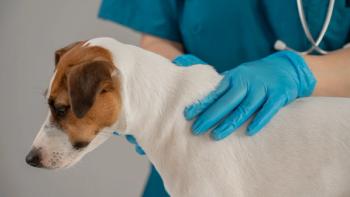
"Don't dress your itchy dog in black": A case approach to seborrhea (Proceedings)
Seborrhea is the abnormal (increased) production of skin cells (keratinocytes) and sebum that manifests clinically as scale and / or increased oil secretions on the skin and hair coat. Most often seborrhea occurs secondary to another dermatologic problem; less often it is a primary problem.
Seborrhea is the abnormal (increased) production of skin cells (keratinocytes) and sebum that manifests clinically as scale and / or increased oil secretions on the skin and hair coat. Most often seborrhea occurs secondary to another dermatologic problem; less often it is a primary problem. Virtually every condition listed in the dermatology textbook can cause seborrhea. Let's make approaching dandruff a little easier by taking a case approach.
Disclaimer: The following cases are embellished examples of real cases. Names have been changed to protect the flakey and data manipulated for a more informative experience.
Seborrhea and the Young Dog
Katie, a 4-month old, 3-pound, long-haired Chihuahua
CC: very flakey skin since acquired at 8 weeks of age
Exam: Tiny and cute. Very large dry flakes of skin on skin on entire body. No significant erythema.
Most likely differentials for seborrhea in young dogs (less than about 1 yr old):
Degen / Anomalous: Primary seborrhea (congenital / hereditary disorder such as icthyosis)
Metabolic: less likely in young dog
Nutrition: Poor diet; nutritional theft by intestinal parasites
Infectious
• External Parasites: Cheyletiella, sarcoptic mange, lice, fleas
• Pyoderma (secondary to something else)
• Dermatophyte infection
• Demodicosis
Immune-mediated much less likely in a young dog
Toxin / Topical reaction
History is the first diagnostic step in dermatology cases
1. Is she itchy? No. This makes scabies, lice and fleas less likely. Cheyletiella may or may not be itchy.
2. Diet? Science Diet Growth Formula
3. Bathing? Moisturizing gentle shampoo from veterinary clinic once every 3 weeks
4. Deworming / fecals? 2 dewormings before 3 months of age
5. Patchy or diffuse scaling? Diffuse. Why do I care? Infectious causes of seborrhea (or any lesion) often cause asymmetrical lesions.
So, what I am left with? Demodex, primary seborrhea, pyoderma, dermatophyte, cheyletiella.
The academic diagnostic approach: skin scrapes and skin cytology. If negative, set up fungal culture, treat empirically for Cheyletiella (Revolution, ivermectin, FL Spray), start antibiotics for pyoderma. If no improvement and fungal culture negative, do skin biopsies.
What I did: Skin scrapes: negative. Wood's Lamp exam: negative. Tape cytology: nsf.
Now "the rest of the story": I previously examined a full-sibling to Katie (different litter) for marked seborrhea. And the bitch to these pups has seborrhea. This is very likely a congenital disorder of keratinization.
I offered biopsies for more insight; declined by owner because of low-risk empiric treatment options.
Treatment: Topical anti-seborrheic shampoo (sulfur + salicylic acid) and moisturizer, oral fatty acids (emphasis on omega 6 fatty acids) and oral vitamin A.
Tangent
Vitamin A and the skin:
• Vitamin A (retinol) plays an important role in regulating normal proliferation and differentiation of keratinocytes and other epithelial tissues. It acts like a steroid hormone, being transported to the cellular nucleus by a binding protein where it influences gene transcription.
• Retinoid effects on the skin include:
o Inhibition of sebum production
o Decreased keratin proliferation in hyperproliferative disorders
o Normalizes the differentiation of keratinocytes
o Stimulates humoral and cellular immunity
o Anti-inflammatory effects via affects cytokines, such as prostglandins
Natural and synthetic retinoids have been beneficial in cases of primary seborrhea (Vitamin A-responsive seborrhea), sebaceous adentitis, cutaneous lymphoma, Schnauzer comedo syndrome, sebaceous hyperplasia / adenomas, and feline acne (topical tx).
Tangent
Vitamin-A responsive seborrhea
• Disorder of keratinization seen starting in young adult dogs
• Most common in cocker spaniels but not limited to this breed
• If this is the only derm problem present, non-pruritic unless secondary infections occur
• Typified by (disproportionately) marked hyperkeratosis of the hair follicles appreciated on biopsy. This appears clinically as follicular casts ("little sweaters" of keratin on the hairs) ± comedones.
• Diagnosis: Histopathologic changes and response to therapy
• Treatment: oral vitamin A, 10,000 IU daily (or 1,000 IU / kg) and topical anti-seborrheic therapy. May take 6 weeks to see response to the vitamin A. I usually add in fatty acids supplements with focus on omega 6 fa's as well (Derm Caps, safflower oil, borage oil).
Katie: after 6 weeks of borage oil, 8,000 IU vitamin A 3x/week and sulfur-salicylic acid prescription shampoo, the scaling remained, but was more than 50% improved and the scales much smaller.
Seborrhea and the Young Adult Dog
Shiloe: 4-year old m/n sheltie CC: 2-year h/o scaling; owner does not report pruritus
Exam: Marked whole body scaling with large flakes and erythema. Thin, oily hair coat on trunk and head, less so on extremities, tail. Pinnal scaling; yellow otic exudate. No fleas. Malodorous.
Differentials
• Metabolic: hypothyroidism; hyperadrenocorticism
Nutritional: "Fatty acid-responsive dermatosis"
• Neoplasia:
• Primary: epitheliotropic lymphoma; exfoliative dermatitis of parapsoriasis.
Secondary (paraneoplastic event) to thymoma, cutaneous lymphoma
• Infectious: Dermatophytosis; pyoderma / Malassezia (secondary to?); Demodex secondary to immune suppression
• Immune: Lupus (cutaneous /systemic); erythema multiforme
Allergic dermatitis* (food, atopy); contact reaction to topical product
• Toxin: no known exposure
Shiloe's Diagnostics
Skin scrapes: negative. Wood's lamp exam: neg. Ear cytology: several yeast, cocci / o.i.f.
Skin cytology (tape impression): 1-4 yeast / "oif", 0-1 wbc and 0-6 cocci / "oif"
CBC, Chemistry Profile, UA and FT4: normal.
Skin biopsy: Complicated: Hyperkeratosis suggestive of a primary seborrhea; evidence of pruritus; and inflammation suggestive of underlying allergic dermatitis.
Assessment
• The yeast and bacterial overgrowths are secondary to an underlying problem (allergic dermatitis). The Malassezia is important to address: Malassezia thrive on oily skin. As they overgrow, they stimulate increased proliferation of keratinocytes, worsening the existing seborrhea.
• Skin biopsy can indicate allergy as an underlying problem but cannot differentiate between food reaction, atopy, or flea bite hypersensitivity. Clinical impression must be used.
Treatment Plan
Cephalexin and ketoconazole, combination topical otic treatment, d/c current shampoo and start Rx anti-microbial shampoo bathing 2x/week, tapering dose of prednisone for 10 days, and a novel-ingredient diet high in fatty acids. Recheck planned for 4 weeks.
At the follow up
Shiloe came in 8 weeks after the first visit. Owner reports Shiloe did well for the first 2 weeks after the last visit, but then skin problems recurred, looking almost as bad as when he first presented. Diet was 90% restricted (as good as we were going to get).
Assessment B
Food trial has not helped; by process of elimination, this leaves us holding a bag that says "atopy ± seborrhea" on it.
Plan B
Antimicrobial medications were resumed. Started on daily Atopica (2.5 mg / kg rather than 5 mg/kg b/c on ketoconazole for yeast) along with treating the microbial overgrowths (again). We did not use any systemic corticosteroids this time.
Why did I choose cyclosporine over allergy testing and immunotherapy or antihistamines + fatty acids in this case?
1. The owner did not wish to pursue allergy testing and had a needle-phobia
2. Cyclosporine works relatively well in control of atopy with fewer predictable side effects than steroids
3. Cyclosporine may have beneficial effects in keratinization disorders. How is unknown, though the speaker's theory is the anti-inflammatory effects of cyclosporine on cytokines down-regulates keratin proliferation.
At a 4-week follow up, Shiloe was 85% better in all respects. Antibiotics discontinued and bathing frequency decreased. By 6 weeks, decreased the frequency of Atopica / ketoconazole to 2-3 times a week. Shiloe continues to do well on this regime.
Seborrhea and the Geriatric Patient
Marked scaling starting in the older dog / cat is never going to be happy news.
"Tyco", 9-year old boxer CC: 4-month h/o scaling, pruritus
Generalized multifocal round areas of large-flake scaling, some crusting. Face and chin most affected. Scaling is a large peeling of epidermis with embedded hairs. Depigmentation on lips and left lateral canthus.
Differentials
• Metabolic: Superficial Necrolytic Dermatitis
• Neoplasia: Cutaneous lymphoma; exfoliative dermatitis secondary to neoplasia
• Immune-mediated: Erythema multiforme; lupus (cutaneous / systemic); pemphigus foliaceus; drug reaction
• Infectious: Demodex (sec to ?); Fungal (dermatophyte); Leishmania; Bacterial / Malassezia secondary to?
Plan: Considering the age of onset, no history of drug administration, this warrants blood work and biopsy for histopathology.
CBC, Chem, T4 / FT4: T4 and FT4 at bottom of normal. UA not obtained.
Biopsy result: Nests and nodules of uniform round cells surrounding hair follicle units and some in the epidermis. Cell morphology consistent with cutaneous lymphoma.
No treatment was instituted and Tyco was lost to follow up. Treatment options would include lomustine orally every 3 weeks or 3 ml / kg safflower oil twice a week.
Management of Seborrhea
Topical therapy is important for some immediate improvement in the appearance and health of the skin. Systemic therapy in seborrhea focuses on nutritional support of the skin and treatment of secondary infections when they arise.
Mild cases of seborrhea sicca
• Question bathing (what kind of shampoo and how often being used?) If owner using a harsh, OTC product regularly, change to reputable, gentle moisturizing shampoo.
• Add omega 6 fa's to diet
• Topical moisturizer with emollients (oils) and hygroscopic agents (propylene glycol, urea, lactic acid, glycerin) to draw and retain moisture in the epidermis (e.g., Humilac, Virbac; Douxo "Calm" or "Seborrhea" Microemulsion spray) after baths
More refractory seborrhea sicca (lacking obvious underlying cause)
• Bathe with shampoo with keratolytic / keratoplastic effects; sulfur / salicylic acid is best combination:
• Sebolux or Keratolux (Virbac)
• Duoxo Anti-seborrheic shampoo (Sogeval)
• DermaSebS or Malacetic shampoo (DermaPet)
• OR a benzoyl peroxide shampoo (Pyoben, Virbac; DermaBenSs, DermaPet)
• Use moisturizer discussed above after and between baths, esp if using benzoyl peroxide shampoo
• Oral fatty acids with omega 6's such EFA caps (Virbac) or Safflower oil: ½ tsp / 10lbs body weight; Sunflower oil: 1.5 tsp / 10 lbs body wt
Derm Disaster Cases (seborrhea sicca and oleosa of Westies and Cockers),
• Benzoyl peroxide or tar-based shampoo (T-gel) or Keratolux until condition better, then sulfur / salicylic acid shampoo
• Post-bath topical moisturizing very important
• Oral fatty acids as listed above plus omega 3's (180 mg /10 lb EPA + DHA); (OmegaDerm - Virbac; Eicosaderm – DermaPet)
• Vitamin A (speaker's opinion)
• Identify and address any underlying problems such as atopy, food hypersensitivity
References
Griffin CE. Cyclosporine Use in Dermatology. In: Bongura and Twedt, eds. Kirk's Current Veterinary Therapy XIV. St. Louis: Saunders Elsevier, 2008; 386-389.
Power HT, Ihrke PJ. Synthetic retinoids in veterinary dermatology. Vet Cli N Am: Small Anim Prac 1990:20; 1525-1539
Scott DW, Miller WH, Griffin CE. Muller and Kirk's Small Animal Dermatology. 6th ed Philadelphia: WB Saunders, 2001.
K S Iwamoto KS, Bennett LR, Norman A, et al. Linoleate produces remission in canine mycosis fungoide. Cancer Lett. May 1992;64(1):17-22.
Newsletter
From exam room tips to practice management insights, get trusted veterinary news delivered straight to your inbox—subscribe to dvm360.




